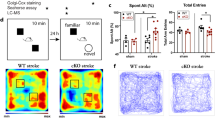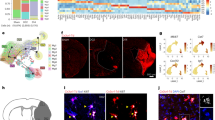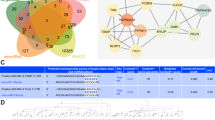Abstract
Ischemic stroke is one of the common causes of disability and death, and subsequent pathological processes consequent to revascularization could promote secondary tissue damage leading to neuronal death, namely cerebral ischemia and reperfusion injury. Neutrophils could invade injured brain parenchyma after vascularization and exert neurotoxicity by forming neutrophil extracellular traps (NETs). However, unwanted NETs were accumulated in the infarcted core of transient middle cerebral artery occlusion (tMCAO) rats and the mechanism is unknown. Efficient microglial phagocytosis is crucial for the homeostasis of cerebral parenchyma after stroke, and dysfunction of microglial phagocytosis of NETs were observed in the infarcted core cortex at tMCAO 1 d and the accumulation of NETs persisted to 7 d, which exerting deleterious neuronal damage after stroke. However, the detailed mechanisms underlying the dysfunction of microglial phagocytosis of NETs remained unclear. Our results further demonstrated that NLRX1 was mainly enhanced in the microglial cells in the infarcted core cortex at tMCAO 1 d and promoted galectin-3 expression on the lysosomes, facilitating the lysosomal dysfunction and impaired microglial phagocytosis via mTOR/TFEB signaling. NLRX1-silencing was able to suppress the galectin-3 intensity, inhibit the phosphorylation of mTOR and facilitate the nuclear localization of TFEB, ameliorating the lysosomal dysfunction and microglial phagocytosis of NETs. Our results uncovered the regulation of NLRX1 in the dysfunctional microglial phagocytosis of NETs and provided insights into the therapeutic potential for targeting at microglial lysosomal function in cerebral ischemia and reperfusion injury.
This is a preview of subscription content, access via your institution
Access options
Subscribe to this journal
Receive 12 print issues and online access
$259.00 per year
only $21.58 per issue
Buy this article
- Purchase on SpringerLink
- Instant access to full article PDF
Prices may be subject to local taxes which are calculated during checkout








Similar content being viewed by others
Data availability
The data supporting our current research are available form the corresponding author on reasonable request.
References
Iadecola C, Buckwalter MS, Anrather J. Immune responsesto stroke: mechanisms, modulation, and therapeutic potential. J Clin Invest. 2020;130:2777–88.
裘佳.中国卒中原创科研声音唱响世界[N].医师报, 2024-06-27(B04). https://doi.org/10.44211/n.cnki.nysbz.2024.000239.
Chamorro Á, Lo EH, Renú A, van Leyen K, Lyden PD. The future of neuroprotection in stroke. J Neurol Neurosurg Psychiatry. 2021;92:129–35.
Kierdorf K, Prinz M. Microglia in steady state. J Clin Invest. 2017;127:3201–9.
Iadecola C, Buckwalter MS, Anrather J. Immune responses tostroke: mechanisms, modulation, and therapeutic potential. J Clin Invest. 2020;130:2777–88.
Beccari S, Sierra-Torre V, Valero J, Pereira-Iglesias M, García-Zaballa M, Soria FN, et al. Microglial phagocytosis dysfunction in stroke is driven by energy depletion and induction of autophagy. Autophagy Jul. 2023;19:1952–81.
Cai W, Liu S, Hu M, Huang F, Zhu Q, Qiu W, et al. Functional dynamics of neutrophils after ischemic stroke. Transl Stroke Res. 2020;11:108–21.
Papayannopoulos V, Metzler KD, Hakkim A, Zychlinsky A. Neutrophil elastase and myeloperoxidase regulate the formation of neutrophil extracellular traps. J Cell Biol. 2010;191:677–91.
Kang L, Yu H, Yang X, Zhu Y, Bai X, Wang R, et al. Neutrophil extracellular traps released by neutrophils impair revascularization and vascular remodeling after stroke. Nat Commun. 2020;11:2488.
Strecker J-K, Schmidt A, Schäbitz W-R, Minnerup J. Neutrophil granulocytes in cerebral ischemia-Evolution from killers to key players. Neurochem Int. 2017;107:117–26.
Otxoa-de-Amezaga A, Miró-Mur F, Pedragosa J, Galliziol M, Justicia C, Gaja-Capdevila N, et al. Microglial cell loss after ischemic stroke favors brain neutrophil accumulation. Acta Neuropathologica. 2019;137:321–41.
Li Peng, Zhou Y, Jiang N, Wang T, Zhu J, Chen Y, et al. DJ-1 exerts anti-inflammatory effects and regulates NLRX1-TRAF6 via SHP-1 in stroke. J Neuroinflam. 2020;17:81.
Kilkenny C, Browne W, Cuthill IC, Emerson M, Altman DG. NC3Rs Reporting Guidelines Working Group. Animal Research: Reporting in vivo Experiments—The ARRIVE Guidelines. J Cereb Blood Flow Metab. 2011;31:991–3.
Pan J, Peng J, Li X, Wang H, Rong X, Peng Y. Transmission of NLRP3-IL-1β Signals in Cerebral Ischemia and Reperfusion Injury: from Microglia to Adjacent Neuron and Endothelial Cells via IL-1β/IL-1R1/TRAF6. Mol Neurobiol. 2023;60:2749–66.
Olmos-Alonso A, Schetters STT, Sri S, Askew K, Mancuso R, Vargas-Caballero M, et al. Pharmacological targeting of CSF1R inhibits microglial proliferation and prevents the progression of Alzheimer’s-like pathology. Brain. 2016;139:891–907.
Bi C, Zhang X, Lu T, Zhang X, Wang X, Meng B, et al. Inhibition of 4EBP phosphorylation mediates the cytotoxic effect of mechanistic target of rapamycin kinase inhibitors in aggressive B-cell lymphomas. Haematologica. 2017;102:755–64.
Schmued LC, Stowers CC, Scallet AC, Xu L. Fluoro-Jade C results in ultra high resolution and contrast labeling of degenerating neurons. Brain Res. 2005;1035:24–31.
Kim S-W, Lee H, Lee H-K, Kim I-D, Lee J-K. Neutrophil extracellular trap induced by HMGB1 exacerbates damages in the ischemic brain. Acta Neuropathol Commun. 2019;7:94.
Russo-Carbolante EMS, Azzolini AECS, Polizello ACM, Lucisano-Valim YM. Comparative study of four isolation procedures to obtain rat neutrophils. Comp Clin Path. 2000;11:71–76.
Peng J, Pan J, Wang H, Mo J, Lan L, Peng Y. Morphine-induced microglial immunosuppression via activation of insufficient mitophagy regulated by NLRX1. J Neuroinflammation. 2022;19:8.
Aits S, Kricker J, Liu B, Ellegaard A-M, Hämälistö S, Tvingsholm S, et al. Sensitive detection of lysosomal membrane permeabilization by lysosomal galectin puncta assay. Autophagy. 2015;11:1408–24.
Roczniak-Ferguson, Petit CS, Froehlich F, Qian S, Ky J, Angarola B, et al. The transcription factor TFEB links mTORC1 signaling to transcriptional control of lysosome homeostasis. Sci Signal. 2012;5:ra42.
Jia J, Abudu YP, Claude-Taupin A, Gu Y, Kumar S, Choi SW, et al. Galectins control mTOR in response to endomembrane damage. Mol Cell. 2018;70:120–135.e8.
Chen X, Yu C, Liu X, Liu B, Wu X, Wu J, et al. Intracellular galectin-3 is a lipopolysaccharide sensor that promotes glycolysis through mTORC1 activation. Nat Commun. 2022;13:7578.
Herre M, Cederval J, Mackman N, Olsson A-K. Neutrophil extracellular traps in the pathology of cancer and other inflammatory diseases. Physiol Rev. 2023;103(Jan):277–312.
Clark SR, Ma AC, Tavener SA, McDonald B, Goodarzi Z, Kelly MM, et al. Platelet TLR4 activates neutrophil extracellular traps to ensnare bacteria in septic blood. Nat Med Apr. 2007;13:463–9. https://doi.org/10.1038/nm1565.
Wang K, Li J, Zhang Y, Huang Y, Chen D, Shi Z, et al. Central Nervous System Diseases Related to Pathological Microglial Phagocytosis. CNS Neurosci Ther. 2021;27:528–39.
Huang Y, Xu Z, Xiong S, Sun F, Qin G, Hu G, et al. Repopulated Microglia Are Solely Derived From the Proliferation of Residual Microglia After Acute Depletion. Nat Neurosci. 2018;21:530–40.
Szalay G, Martinecz B, Lénárt N, Környei Z, Orsolits B, Judák L, et al. Microglia Protect Against Brain Injury and Their Selective Elimination Dysregulates Neuronal Network Activity After Stroke. Nat Commun. 2016;7:11499.
Schilling M, Besselmann M, Müller M, Strecker JK, Ringelstein EB, Kiefer R. Predominant phagocytic activity of resident microglia over hematogenous macrophages following transient focal cerebral ischemia: an investigation using green fluorescent protein transgenic bone marrow chimeric mice. Exp Neurol. 2005;196:290–7.
Neumann J, Sauerzweig S, Rönicke R, Gunzer F, Dinkel K, Ullrich O, et al. Microglia cells protect neurons by direct engulfment of invading neutrophil granulocytes: a new mechanism of CNS immune privilege. J Neurosci. 2008;28:5965–75.
Neumann J, Riek-Burchardt M, Herz J, Doeppner TR, König R, Hütten H, et al. Very-Late-Antigen-4 (VLA-4)-Mediated Brain Invasion by Neutrophils Leads to Interactions With Microglia, Increased Ischemic Injury and Impaired Behavior in Experimental Stroke. Acta Neuropathol. 2015;129:259–77.
Singh K, Roy M, Prajapati P, Lipatova A, Sripada L, Gohel D, et al. NLRX1 regulates TNF-alpha-induced mitochondria-lysosomal crosstalk to maintain the invasive and metastatic potential of breast cancer cells. Biochim Biophys Acta Mol Basis Dis. 2019;1865:1460–76.
Zoncu R, Efeyan A, Sabatini DM. mTOR: from growth signal integration to cancer, diabetes and ageing. Nat Rev Mol Cell Biol. 2011;12:21–35.
Settembre C, Zoncu R, Medina DL, Vetrini F, Erdin S, Erdin SU, et al. A lysosome-to-nucleus signalling mechanism senses and regulates the lysosome via mTOR and TFEB. EMBO J. 2012;31:1095–108.
Peña-Llopis S, Vega-Rubin-de-Celis S, Schwartz JC, Wolff NC, Tran TAT, Zou L, et al. Regulation of TFEB and V-ATPases by mTORC1. EMBO J. 2011;30:3242–58.
Sardiello M, Palmieri M, di Ronza A, Medina DL, Valenza M, Gennarino VA, et al. A gene network regulating lysosomal biogenesis and function. Science. 2009;325:473–7.
Sha Y, Rao L, Settembre C, Ballabio A, Eissa NT, et al. STUB1 regulates TFEB-induced autophagy-lysosome pathway. EMBO J. 2017;36:2544–52.
Castellano BM, Thelen AM, Moldavski O, Feltes MK, van der Welle REN, Mydock-McGrane L, et al. Lysosomal cholesterol activates mTORC1 via an SLC38A9-Niemann-Pick C1 signaling complex. Science. 2017;355:1306–11.
Fekete T, Bencze D, Bíró E, Benkő S, Pázmándi K. Focusing on the Cell Type Specific Regulatory Actions of NLRX1. Int J Mol Sci. 2021;22:1316.
Allen IC, Moore CB, Schneider M, Lei Y, Davis BK, Scull MA, et al. NLRX1 protein attenuates inflammatory responses to virus infection by interfering with the RIG-I-MAVS signaling pathway and TRAF6 ubiquitin ligase. Immunity. 2011;34:854–65.
Moore CB, Bergstralh DT, Duncan JA, Lei Y, Morrison TE, Zimmermann AG, et al. NLRX1 is a regulator of mitochondrial antiviral immunity. Nature. 2008;451:573–7. https://doi.org/10.1038/nature06501.
Xia X, Cui J, Wang HY, Zhu L, Matsueda S, Wang Q, et al. NLRX1 negatively regulates TLR-induced NF-κB signaling by targeting TRAF6 and IKK. Immunity. 2011;34:843–53.
Arnoult D, Soares F, Tattoli I, Castanier C, Philpott DJ, Girardin SE, et al. An N-terminal addressing sequence targets NLRX1 to the mitochondrial matrix. J Cell Sci. 2009;122:3161–8.
Tattoli I, Carneiro LA, Jéhanno M, Magalhaes JG, Shu Y, Philpott DJ, et al. NLRX1 is a mitochondrial NOD-like receptor that amplifies NF-kappaB and JNK pathways by inducing reactive oxygen species production. EMBO Rep. 2008;9:293–300.
Yin H, Sun G, Yang Q, Chen C, Qi Q, Wang H, et al. NLRX1 accelerates cisplatin-induced ototoxity in HEI-OC1 cells via promoting generation of ROS and activation of JNK signaling pathway. Sci Rep. 2017;7:44311.
Funding
This work was supported by the Natural Science Foundation of Guangdong Province (No. 2022A1515110616 to Jialing Peng), Plan on enhancing scientific research in GMU (No. 02-410-2302027XM to Jialing Peng), Science and Technology Projects in Guangzhou (No. 2024A04J3703 to Jialing Peng), National Natural Science Foundation of China (No. 82371186 to Jun Liu, No. 82401401 to Jialing Peng) and Key Technologies R&D Program of Guangzhou (No: 202206010007 to Jun Liu). The work was also supported by Guangzhou Medical Key Discipline Construction Project (2025-2027).
Author information
Authors and Affiliations
Contributions
JLP designed and performed the experiments, wrote the original draft and analyzed the data. YXH analyzed the data and revised the manuscript. TJH performed the data curation and review and editing. YZ provided suggestions, guided the research and revised the manuscript. JL performed the funding acquisition and supervision and review. All authors read and approved the final manuscript.
Corresponding authors
Ethics declarations
Competing interests
The authors declare no competing interests.
Ethics approval and consent to participate
All animal experiments were approved by Animals Care and Use Committee of the Second Affiliated Hospital of Guangzhou Medical University (Approval Number, A2022-042). We designed, performed and reported the experiments in accordance with the Animal Research Reporting of In Vivo Experiments (ARRIVE) guidelines [13].
Consent for publication
All authors approved the final manuscript and the submission.
Additional information
Publisher’s note Springer Nature remains neutral with regard to jurisdictional claims in published maps and institutional affiliations.
Rights and permissions
Springer Nature or its licensor (e.g. a society or other partner) holds exclusive rights to this article under a publishing agreement with the author(s) or other rightsholder(s); author self-archiving of the accepted manuscript version of this article is solely governed by the terms of such publishing agreement and applicable law.
About this article
Cite this article
Peng, J., Huang, Y., He, T. et al. NLRX1 mediated impaired microglial phagocytosis of NETs in cerebral ischemia and reperfusion injury. Cell Death Differ (2025). https://doi.org/10.1038/s41418-025-01526-3
Received:
Revised:
Accepted:
Published:
DOI: https://doi.org/10.1038/s41418-025-01526-3



